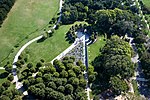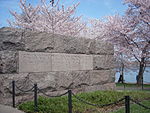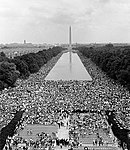West Potomac Park

West Potomac Park is a U.S. national park in Washington, D.C., adjacent to the National Mall. It includes the parkland that extends south of the Lincoln Memorial Reflecting Pool, from the Lincoln Memorial to the grounds of the Washington Monument. The park is the site of many national landmarks, including the Korean War Veterans Memorial, Jefferson Memorial, Franklin Delano Roosevelt Memorial, George Mason Memorial, and the Martin Luther King Jr. Memorial. The park includes the surrounding land on the shore of the Tidal Basin, an artificial inlet of the Potomac River which was created in the 19th century, an inlet that links the Potomac with the northern end of the Washington Channel. West Potomac Park is administered by National Mall and Memorial Parks, an administrative unit of the National Park Service's National Capital Parks.
Excerpt from the Wikipedia article West Potomac Park (License: CC BY-SA 3.0, Authors, Images).West Potomac Park
Independence Avenue Southwest, Washington
Geographical coordinates (GPS) Address Nearby Places Show on map
Geographical coordinates (GPS)
| Latitude | Longitude |
|---|---|
| N 38.886 ° | E -77.047 ° |
Address
Field #8
Independence Avenue Southwest
20418 Washington
District of Columbia, United States
Open on Google Maps










